US Carrier Enters Persian Gulf, Within Range of Iran’s Missiles, as War of Words with Mullahs Heats Up
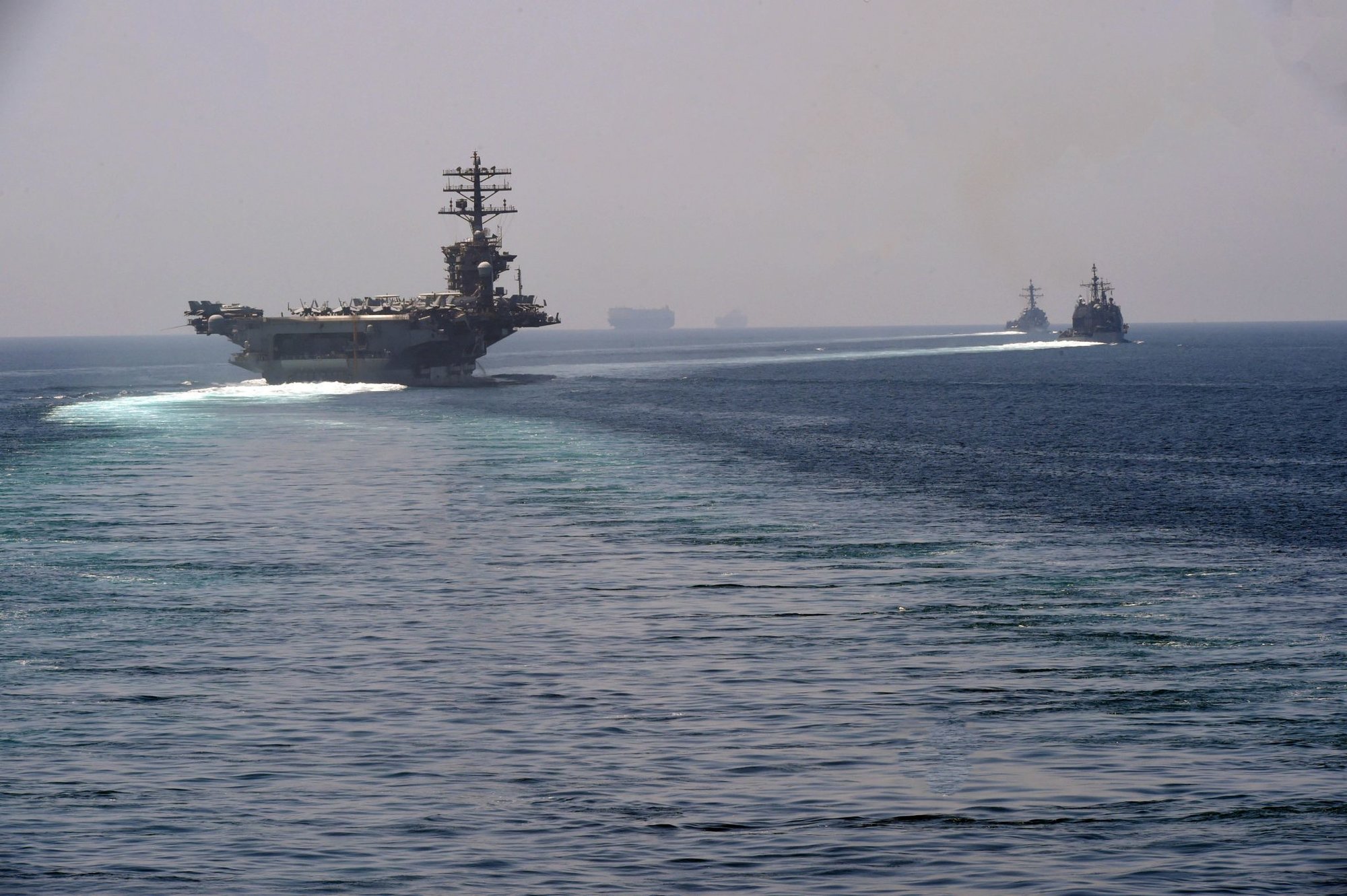
STRAIT OF HORMUZ (Sep. 18, 2020) The aircraft carrier USS Nimitz (CVN 68), guided-missile cruiser USS Princeton (CG 59) and guided-missile destroyer USS Sterett (DDG 104) steam in formation during a Strait of Hormuz transit, Sept. 18. U.S. Navy photo by Mass Communication Specialist 2nd Class Indra Beaufort.
For the first time in about 10 months, a US aircraft carrier is in the Persian Gulf and within range of Iran’s anti-ship missiles.
On Friday morning the USS Nimitz, which had been in the North Arabian Sea for months, passed through the Strait of Hormuz along with the guided-missile cruisers USS Princeton and USS Philippine Sea, as well as the guided-missile destroyer USS Sterett. The last US carrier to operate in the Persian Gulf was the USS Abraham Lincoln, which left in December.
The Nimitz Carrier Strike Group is “at the peak of readiness,” said Rear Adm. Jim Kirk, commander of the strike group.
The move comes only months after the Air Force ended its long-term bomber deployments to al Udeid Air Base in Qatar due, in part, to the threat of Iran’s missiles. The Nimitz also enters the Persian Gulf at a tumultuous moment in relations between Washington and Tehran. On Sunday, Secretary of State Mike Pompeo announced that the US was unilaterally reinstating UN sanctions against Tehran for its nuclear program — a move known as the “snapback” provision in the 2015 agreement hashed out by the Obama administration.
“The 2015 nuclear deal did not induce Iran to join ‘the community of nations’ as promised. Instead, the mullahs took their newfound wealth and used it to foment death and destruction from Yemen to Iraq to Lebanon and Syria — a predictable outcome,” Pompeo said in a Saturday statement posted to the State Department’s website.
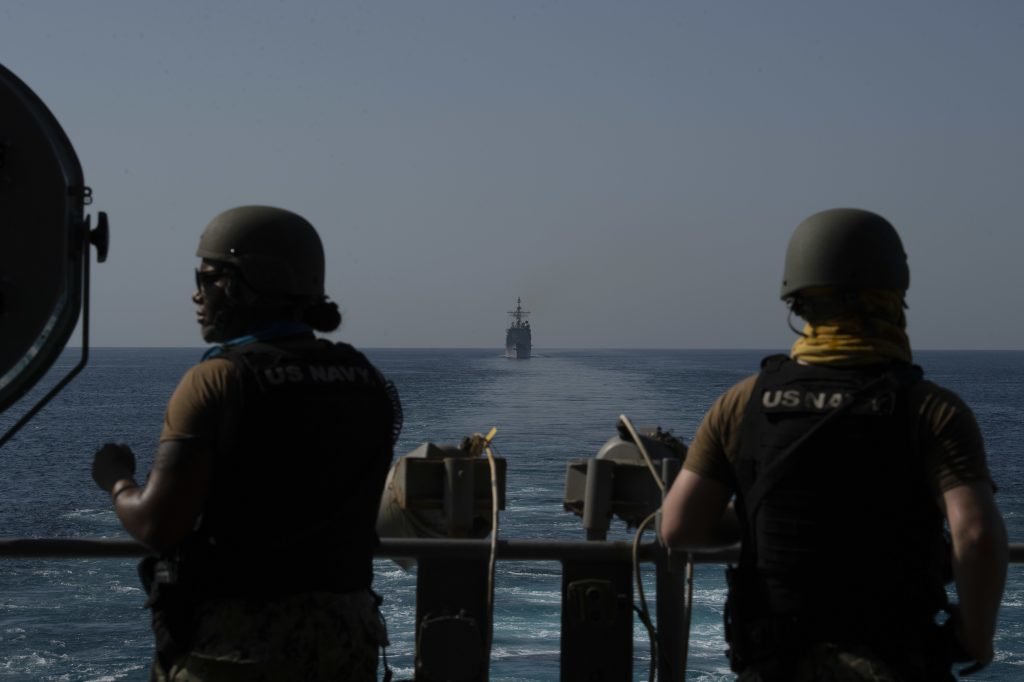
Iran’s January ballistic missile strikes on US forces stationed at al Asad and Erbil bases in Iraq, in which some 110 US service members suffered traumatic brain injuries, was one factor that spurred Air Force Global Strike Command to curtail long-term bomber deployments to al Udeid.
“It didn’t take al Asad for me to see that you don’t want to park your strategic assets in the ballistic missile engagement zone. We’ve thought like that for a long time,” Air Force Gen. Tim Ray, commander of Air Force Global Strike Command, said in April.
Iran reportedly tested a new generation of short- and long-range anti-ship cruise missiles in June. And on July 28, American personnel at al Udeid and al Dhafra Air Base in the United Arab Emirates took shelter following what was later determined to be Iran’s firing of missiles at the mock-up of a US aircraft carrier positioned in the Strait of Hormuz.
“Iran has carried out cruise missile strikes on a mock carrier in exercises. Any cruise missile is a threat to any carrier,” Thomas Moore, a former senior professional staff member for the Senate Committee on Foreign Relations, told Coffee or Die Magazine.
Iran’s Islamic Revolutionary Guard Corps navy also regularly operates patrol boats in the Persian Gulf, which have harassed US Navy vessels in the past.
The US withdrew from the 2015 nuclear deal, known as the Joint Comprehensive Plan of Action, or JCPOA, in May 2018. The Trump administration said the Obama-era agreement didn’t do enough to curb Tehran’s destabilizing behavior across the Middle East or its ballistic missile program. Also, the JCPOA called for many of the restrictions on Iran’s nuclear program to be lifted after 15 years. Trump repeatedly criticized those so-called sunset provisions, claiming they would allow Tehran to acquire a bomb in the not-too-distant future.
“We will never let the world’s leading state sponsor of terror obtain the world’s most deadly weapon,” Pompeo said.
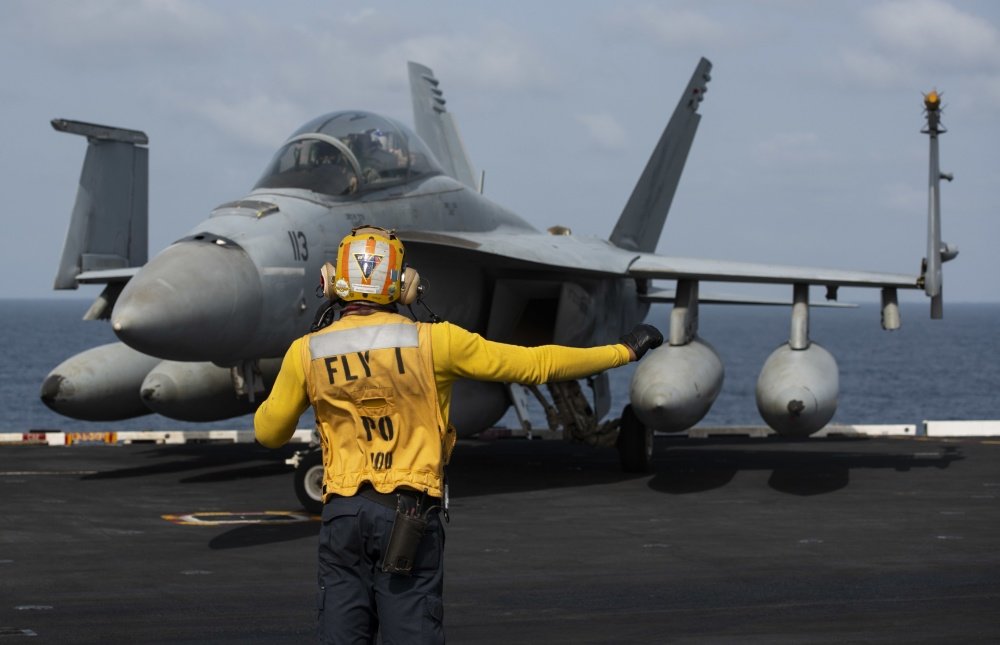
As part of Trump’s so-called maximum pressure campaign against Iran, renewed American sanctions have targeted the Islamic Republic’s financial and industrial sectors, more than halving the country’s daily oil exports to around 1 million barrels in the process. Consequently, Iran’s economy has gone into a tailspin and unemployment has soared. Nevertheless, the mullahs have not abandoned their program to enrich uranium. In June the International Atomic Energy Agency estimated it would take Iran three to six months to manufacture enough weapons-grade material to produce a nuclear weapon.
Under economic pressure from US sanctions, Iran has also ratcheted up its so-called gray zone activities. To that end, Iran has resorted to unconventional attacks by proxies, as well as nonlethal acts of aggression like the sabotage of oil tankers and pipelines.
Both US and Iranian officials have said they don’t want a war. Yet the two sides have gone to the brink of conflict several times in recent years. In April 2019, the Trump administration designated Iran’s Islamic Revolutionary Guard Corps as a foreign terrorist organization. Iran, in turn, declared US Central Command a terrorist group.
US officials said Iran used magnetic mines to attack four tankers in the Gulf of Oman in May 2019. Tehran, in turn, denied the allegations. A month later, Iranian forces shot down a US RQ-4A Global Hawk unmanned aerial vehicle with a surface-to-air missile. Trump authorized retaliatory airstrikes but reportedly called them off with only 10 minutes to spare. Ultimately, the US opted for a retaliatory cyberattack, instead.
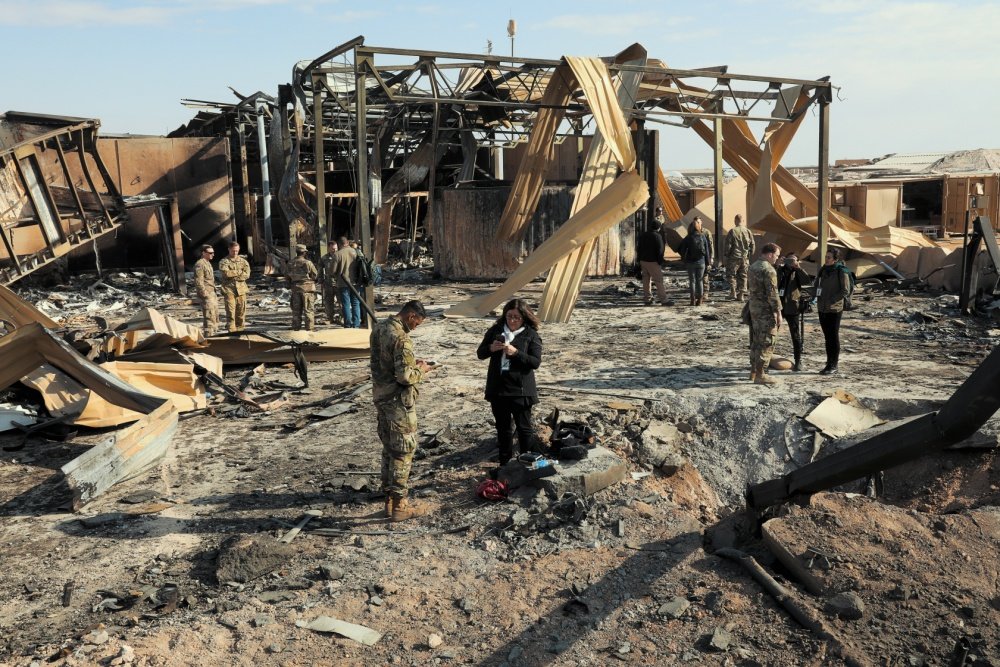
In response to intelligence suggesting Iran may be poised to strike US interests or personnel in the Middle East, in May 2019 the Trump administration sent the USS Abraham Lincoln aircraft carrier to the Middle East, along with bombers and fighter jets, and announced plans to deploy an additional 1,500 troops to the region. The US also stepped up arms sales to its allies, including Saudi Arabia and the United Arab Emirates, in an effort to deter Iran.
The Lincoln’s deployment last year was meant “to send a clear and unmistakable message to the Iranian regime that any attack on United States interests or on those of our allies will be met with unrelenting force,” John Bolton, who was national security adviser at the time, said in a May 2019 statement.
A US airstrike in Iraq on Jan. 3 killed Qassem Soleimani, commander since 1998 of Iran’s Quds Force, which conducts military and spying operations outside the nation’s borders. Soleimani, who was 62 when he died, also held the rank of major general in leading Iran’s Islamic Revolutionary Guard Corps.
The airstrike that killed Soleimani near Baghdad International Airport disrupted an “imminent attack” in the region and saved American lives, Pompeo said in January. Iran’s Supreme Leader Ayatollah Ali Khamenei immediately vowed revenge for Soleimani’s death, reportedly saying: “A harsh retaliation is waiting for the criminals whose filthy hands spilled his blood.”
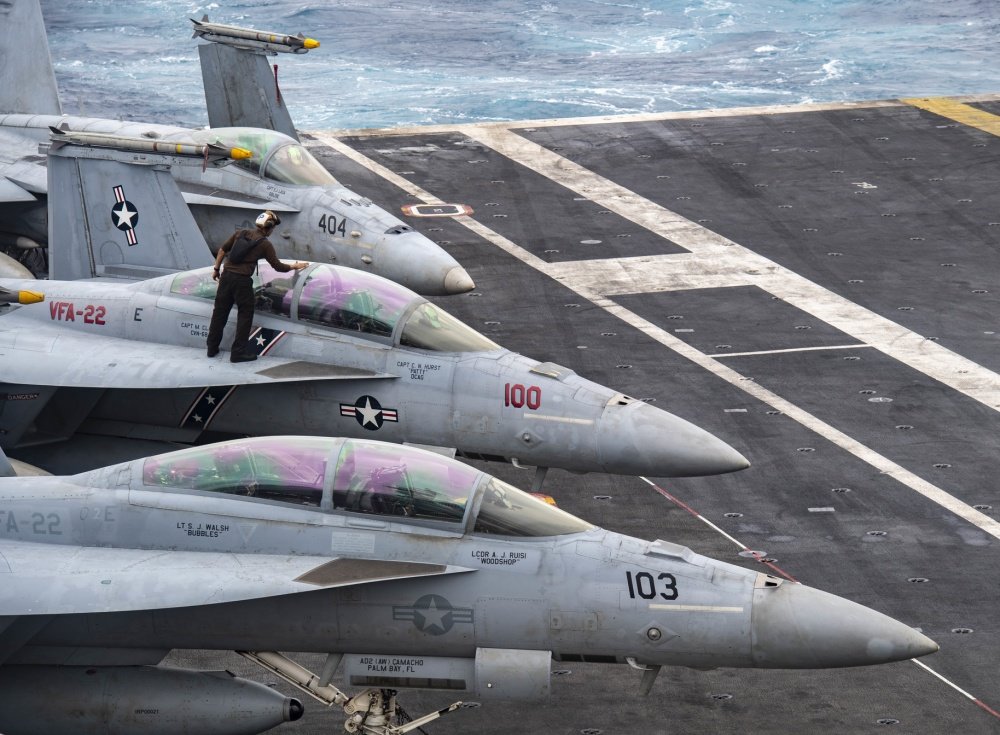
Over the weekend, the commander of Iran’s Revolutionary Guard Corps, Hossein Salami, reiterated that earlier call for revenge, claiming that Iran “will hit the people who, directly and indirectly, played a role in the martyrdom of the great man [Soleimani].”
Politico reported on Sept. 13 about an alleged Iranian plot to assassinate Lana Marks, the US ambassador to South Africa, in retaliation for Soleimani’s death. Tehran denied the report. For his part, Salami said Iran would exact revenge but in an “honorable, fair and just manner, not on a female ambassador to South Africa.”
“If a hair is missing from an Iranian, we will burn all of your hair. These threats are serious. We won’t do verbal fights. We will leave everything to the field of action. We will go on, with confidence and strength,” Salami said in a Saturday address to Iranian military commanders, the Tasnim News Agency reported.
Since May of 2019, the US Navy has maintained a constant carrier presence in the North Arabian Sea and the Gulf of Oman, which are located on the opposite side of the Strait of Hormuz from the Persian Gulf. According to a Navy press release, while in the Persian Gulf the Nimitz will conduct training and will support the coalition war effort against ISIS, Operation Inherent Resolve.
“The carrier’s presence demonstrates the US Navy’s capability to fly, sail and operate wherever international law allows in support of routine and contingency operations,” said Vice Adm. Samuel Paparo, commander of US Naval Forces Central Command, in a release.

BRCC and Bad Moon Print Press team up for an exclusive, limited-edition T-shirt design!
BRCC partners with Team Room Design for an exclusive T-shirt release!
Thirty Seconds Out has partnered with BRCC for an exclusive shirt design invoking the God of Winter.
Lucas O'Hara of Grizzly Forge has teamed up with BRCC for a badass, exclusive Shirt Club T-shirt design featuring his most popular knife and tiomahawk.
Coffee or Die sits down with one of the graphic designers behind Black Rifle Coffee's signature look and vibe.
Biden will award the Medal of Honor to a Vietnam War Army helicopter pilot who risked his life to save a reconnaissance team from almost certain death.
Ever wonder how much Jack Mandaville would f*ck sh*t up if he went back in time? The American Revolution didn't even see him coming.
A nearly 200-year-old West Point time capsule that at first appeared to yield little more than dust contains hidden treasure, the US Military Academy said.












